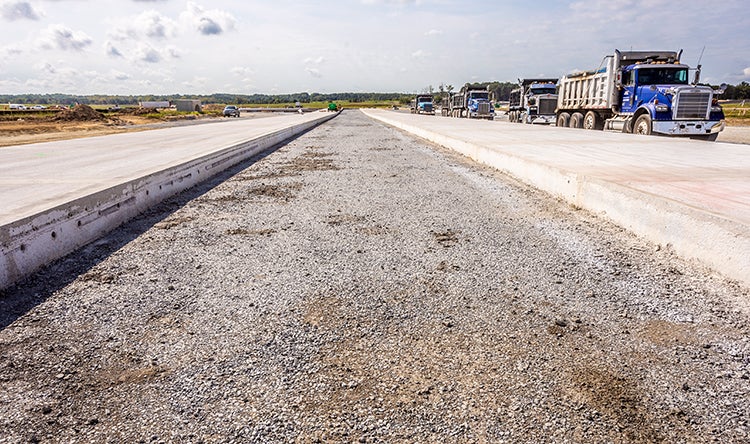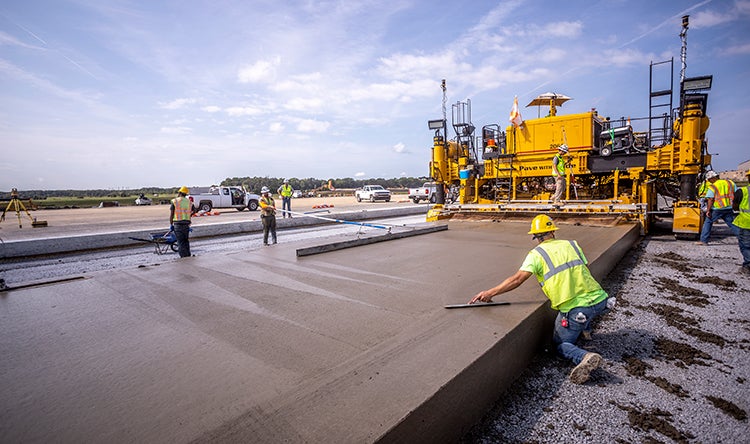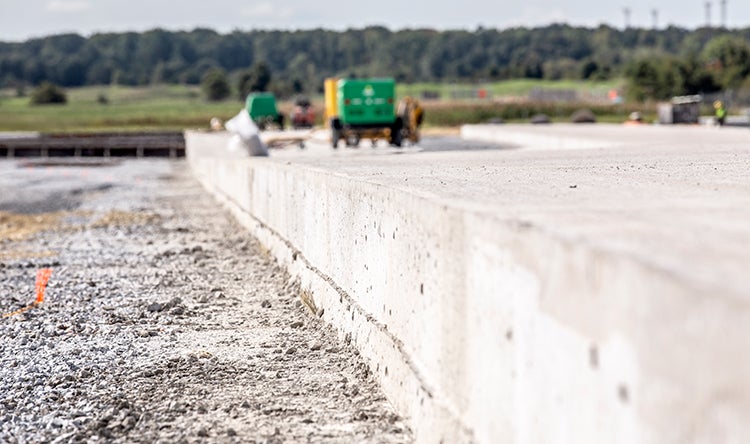
Experts Talk: Durable Airfield Pavement Solutions with BJ Skar
Experts Talk is an interview series with technical leaders from across our transportation program.
Designing Long-Lasting Airfield Paving Projects with Flexibility
With increasingly tight budgets for airfield pavement construction, renovations and repairs, it’s vital to ensure that new pavement is durable and the service life of existing pavement is extended. The right expertise and the right approach can mean less disruption to operations and more flexibility for airfields going into the future.
BJ Skar, P.E., is a senior airfield paving engineer with more than four decades of experience working on military and commercial airfields. He previously served as the senior airfield engineer for the U.S. Army Corps of Engineers’ Transportation Systems Center, and he is still an instructor for the U.S. Department of Defense Airfield Design Course. At HDR, he is part of a worldwide network of airfield paving experts that stretches from HDR’s headquarters in Omaha across the U.S. and globe. In this interview he discusses how to tailor projects to each unique airfield, design a preventive maintenance program and create durable pavement projects that will serve airport facilities for decades.
Skar has overseen planning, design and construction of various aviation projects including runways, taxiways, aprons, air traffic control towers, weapons systems facilities, lighting projects and more. His work has included facilities as varied as Kodiak Airport in Alaska, the Kwajalein Atoll in the Marshall Islands, Fort Lauderdale-Hollywood International Airport in Florida and Joint Base Andrews in Maryland, the home of Air Force One.
Durable Airfield Pavement Solutions
Q. Each airport is different, and each runway and section of an airfield is different. How do we develop plans that are unique to each set of circumstances?
A. In my experience, it always starts with mission. At a commercial airport it's “What are your functions,” and you tailor the strength and the geometrics of the pavement and the facilities to accommodate what you're trying to do. In the military world, we still have baggage and passengers, but we also deal with the weapons and explosives both as cargo and in or on armed aircraft.
Much of pavement design depends on the aircraft that will use the facility. The military’s F-35 jets, for instance, create a lot of high-temperature exhaust that can be tough on pavement, requiring particular attention to how those surfaces are treated. In the commercial world, the 727 used to be called the “pavement jackhammer” for the damage it did with its weight concentrated on fewer tires. The 777 now has a similar reputation. In those instances, you need to make sure to direct the aircraft to just the sections of pavement that are strong enough to support it. Knowing the planes that will be used determines the pavement features needed.
Then we also look to the future and see what else might be coming in, to try to accommodate change. For example, in most places DOD aircraft are parked on the same mass parking apron, so you want flexibility for that apron. That way, when new aircraft arrive in 10 or 15 years, those planes might also be able to use those facilities.
As these plans are developed, it’s important to have an experienced designer who knows what’s possible, what’s not and what could be accomplished with some modifications.
Q. How should owners approach preventive maintenance to extend the life of their pavement?

A. Preventive maintenance should begin with a strong operations and maintenance plan for pavements. As a starting point, this should include an inventory of each pavement feature including forecasted traffic, subgrade soils condition and strength, as-built conditions and maintenance activity. A visual pavement inspection program should also be established that rates the current condition of the pavement surface, with repeat inspections on a regular basis such as every three to five years.
The inspection plan will allow the owner to prioritise and schedule their maintenance plan based on that report until the next report is generated. Pavement repair plans are created using the results of the visual pavement inspection to prioritise areas to be repaired. This is where experience plays a big part in the process. Experienced pavement experts will know what features need to be repaired first and which need to be repaired together to minimise impacts to aircraft operations. Sometimes fixing the worst condition pavement is not the top priority and may not be the most cost-effective strategy.
Q. Preventive maintenance can go only so far, and airfield pavement upgrades will eventually be needed. How can durability be prioritised from the beginning of work on these significant investments?
A. Start with a long-term estimate of aircraft traffic, since growth and changes to aircraft types are hard to predict over a period of 20 years. Commercial airlines have been moving toward larger aircrafts to meet demand without increasing number of operations. A prudent estimate of aircraft traffic and impacts will provide protection against unanticipated changes in aircraft volume and/or weights.
During the design and planning process, pay particular attention to the most demanding aircraft. That may be more than one aircraft. For example, maybe one has the largest wingspan and may establish the geometric layout while another requires the sturdiest pavement section.
Whatever the aircraft traffic, the thicker the pavement you build, the longer aircraft can function on that pavement before it fails. By using the right pavement design techniques, we can accommodate future growth forecasts over a variety of scenarios so that an investment in a thicker pavement section saves maintenance, rehabilitation and replacement costs in the future. And it does not take too much in thickness to make a difference. For example, if you add an inch of thickness, you’ve probably extended the life of up to 50 percent.
Q. Share some examples of how pavement work can be completed while minimising the impact to operations.

A. No matter the project, nobody wants to shut their runway down. Obviously, if you only have one runway, eventually you have to replace the entire runway and there will come a time when part of the runway will be shut down and nothing's happening. But by and large, there are ways to work around shutting runways down and keeping them operational, including phasing construction over larger areas, such as multiple gates over an apron. This can reduce the days needed for construction and improve construction quality. Early communication allows the airlines to adjust or modify their gate use.
Other options include using early strength concrete for repairs in areas where only nightly closures are possible, selecting mix designs so that pavement can be placed in fewer lifts, reusing existing unbound base/subbase where possible or adding contractual monetary incentives for accelerated construction to encourage innovation and the use of multiple crews.
On one project for the military, we let aircraft land on one half the width of the runway while we repaired the other half. Another option is a half closure, to shut down the runway at night when there are fewer operations. For bituminous pavements, oftentimes a mill-and-fill operations can occur at night under lights and then you're ready to reopen to air traffic in the morning. There are weekend shutdowns where the work is conducted after the last aircraft comes in on Friday at 10 at night and before the next one goes out at Monday at 5 in the morning.
There are also ways of displacing the runway threshold. In other words, say you have a 10,000 foot runway. With careful planning, including time of year and aircraft substitutions, it may be possible to temporarily operate on 6,000 feet, so you can work on 3,000 feet of it and then turn around and work on the other 3,000 feet on the other end, making any shutdown to work on the remaining piece much shorter than otherwise needed.
Q. What are the top 3 things airfield owners should do when starting or completing a pavement project?
A. As I stated at the top of the discussion, the most important thing is to understand the mission of the airfield and its needs. But beyond that, three things come to mind: planning for the operational needs; sweat the details; and prioritising construction oversight.
Planning for the operational needs: Owners can really help designers by understanding and relaying the operational needs of a project. It is critical to partner with the designer, engineer and contractor to find the needed time and access. In this day of heightened airport security, for instance, how are hundreds of trucks full of rock going to be moved onto the facility to make concrete? Depending on the airport or facility, some locations might not have performed this sort of construction for 10 or 15 years and so these considerations have to be figured out for the first time in recent memory.
Sweat the details: Prolonging the life of pavement and creating durable material depends heavily on the types of aggregates that go into it. Failures are almost always a failure of the materials put into the paving system. With Portland cement concrete you've got to worry about the types of aggregates and particularly about alkali silica reaction. As new pavement is laid, knowing the impact of the materials in the mix is important and will play a major role in the strength of that pavement over time. It is also critical to ensure that FAA or DOD guides for material are used, and not state department of transportation road specifications.
Prioritise construction oversight: It’s important to have quality assurance inspectors from the owner’s perspective, keeping track of what contractors are supposed to be doing and making sure that all the things are being done according to specifications, whether the dowels are aligned properly, saw cuts are the right depth and more. Every detail matters, and careful oversight is key to ensuring that the project is constructed the way it is designed.

Inspiration and Advice
Q. What inspired you to become an expert in aviation engineering and airfield pavement in particular?
A. About 35 years ago, I worked with the Army Corps of Engineers doing civil engineering work on dams. After a few years, the opportunity presented itself to move from dams to military construction, and after that it was all over. I really enjoyed those projects, particularly their faster pace. I got started with the B-1 bed-down facilities at Ellsworth Air Force Base, then helped start the U.S. Army Corps of Engineers Transportation Systems Center in Omaha, focusing on airfield pavement. The rest is history.
Q. What perspective do you have for aspiring engineers interested in the aviation industry?
A. What I’d like to get across to young engineers is that this field will take you many different places and into many different cultures. Like the old saying, “Join the Navy and see the world,” I’ve seen the world through projects across the globe. I’ve seen the pyramids in Egypt, the Colosseum in Rome, NATO headquarters in Belgium and much more. HDR has done work in Europe, Australia, Japan, the Pacific, South America and more. It’s a global effort, and you might end up somewhere you didn’t expect.
Each Experts Talk interview illuminates a different aspect of transportation infrastructure planning, design and delivery. Check back regularly to gain insights from specialised experts and thought leaders behind our award-winning, full service consulting practice.



